FLATLINERS (1990)
Five medical students experiment with "near death" experiences, until the dark consequences of past tragedies begin to jeopardise their lives.
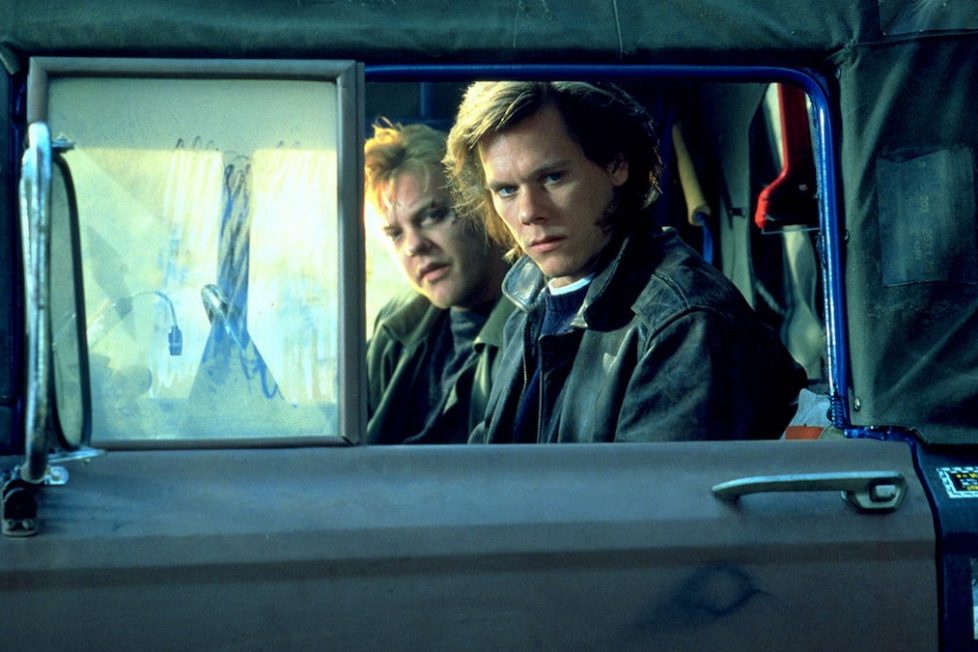
Five medical students experiment with "near death" experiences, until the dark consequences of past tragedies begin to jeopardise their lives.


If you like Halloween Goth, Flatliners is a film you’ll enjoy. It’s 30 years old but still has a concept and style that appeals. It’s an exploration of man’s hubris, how arrogance and knowledge can only take you a certain way and at some point, you need to take a leap of faith. Its subject matter is Near-Death Experiences (NEDs) which remain sensitive, controversial, and subject to investigation. (A scientific paper on NDEs was published only last year.) It’s also about friendship and competition between ambitious young medics which, as we know from the success of TV shows like Grey’s Anatomy, is always a winner.
Peter Filardi’s screenplay was inspired by the near-death experience of a friend undergoing medical treatment. These events seem to contain certain common elements: life flashing before your eyes, a tunnel with a bright light at the far end, a sense of bliss and being ‘at one’ with the universe. It’s a phenomenon that fascinates each generation. Filardi previously only had a few TV credits to his name so this was his first film script. It triggered a bidding war and a handsome first fee. He later wrote The Craft (1996), another successful cult movie about outcast teenage girls who experiment with witchcraft
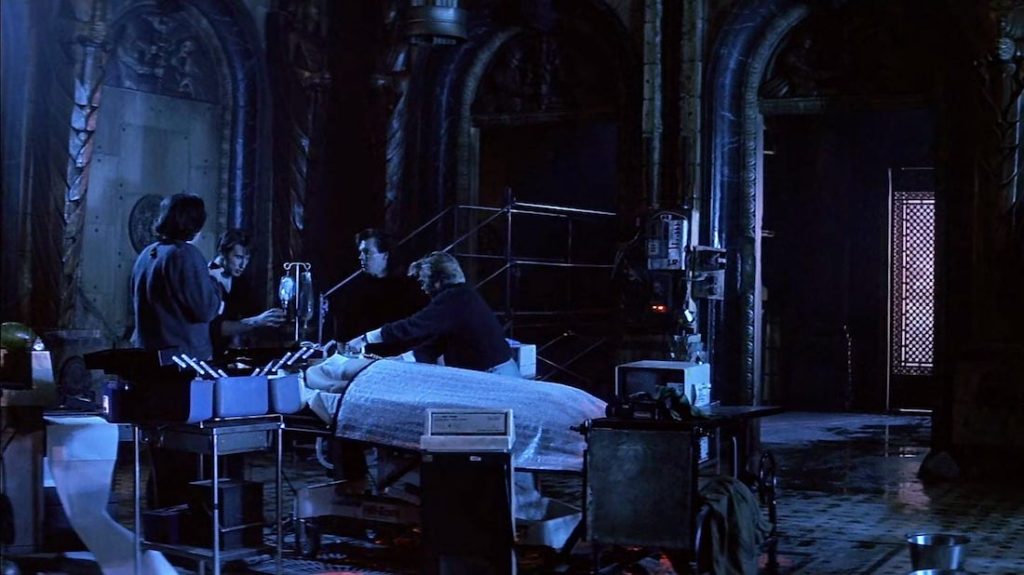
Columbia Pictures bought the script and producer Michael Douglas invited Joel Schumacher (The Lost Boys) to direct. Schumacher got the call after a weekend filming a documentary at an AIDs care home, so matters of life and death were much on his mind.
There was talk of incomplete business with family and loved ones. All this was ringing in my head when I got back… it seemed fatalistic that I [then] read the script, which had to do with what I had just encountered. I think everyone at some time or other ponders the issue of life after death—after all, it’s the ultimate secret—but very few of us would be brave, or foolish, enough to deliberately explore the possibility. But these five students deliberately ‘flatline’, which is the term used for no pulse, no heartbeat, no brain activity, to try and find some answers. Of course, they get more than they bargained for, and ultimately there’s a heavy price to pay.’—Joel Schumacher
This foolish or courageous recklessness seems an aspect of cutting-edge science and medicine—some will deliberately risk their lives in pursuit of breakthroughs. Historic examples include Pasteur, who pioneered vaccination techniques in the 19th-century, and once secured saliva from a rabid dog to transfer to a test tube ‘held between his teeth’ at considerable risk to himself. Charles Darwin, when collecting beetles, would sometimes store them in his mouth until he found another container!
Keifer Sutherland, son of screen legend Donald, had already worked with Schumacher on The Lost Boys and was chosen for the maverick lead character, Nelson Wright…
I knew he was exactly what I wanted for this character. Kiefer has this great intensity and driven quality, and he’s the one who really persuades the others to go along with the experiment.—Joel Schumacher
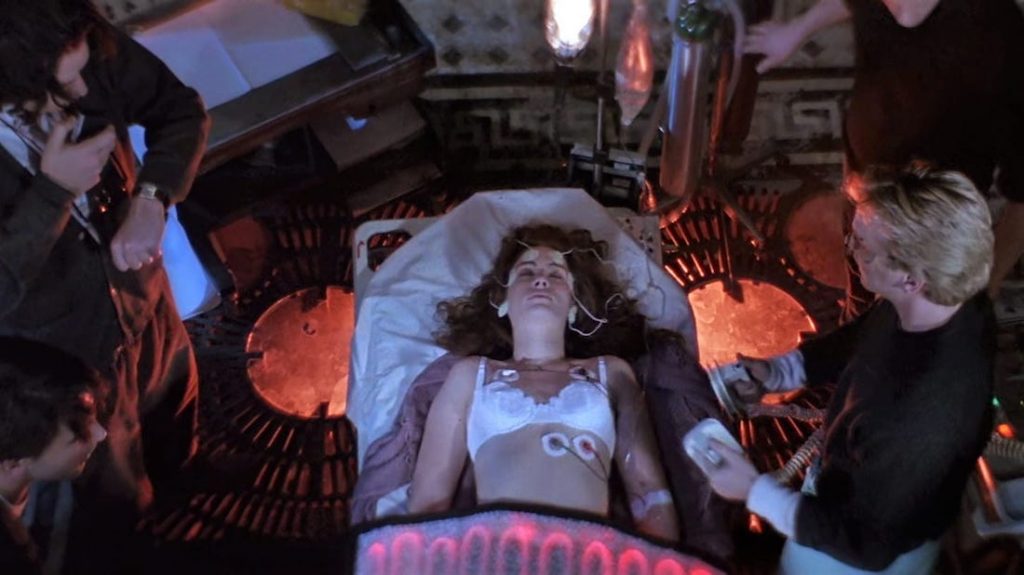
Kevin Bacon, William Baldwin, Oliver Platt, and Julia Roberts were chosen to play the other ambitious medical students. All these young actors were talented and achieving relatively recent success in Hollywood. Bacon was most prolific in the 1980s after Friday the 13th (1980) led to Footloose (1984), here starring as David Lobraccio
Julia Roberts had already appeared in the cult romantic drama Mystic Pizza (1988) and, coincidentally, writer Filardi came from the real Mystic, a scenic fishing town in Connecticut! In Flatliners, Roberts plays the aloof and unfocused Rachel Mannus, with Nelson and Labraccio as rivals for her affections. Behind-the-scenes, she and Kiefer Sutherland were actually an item while filming Flatliners, although the couple never married.
The beautiful exteriors were filmed on location in Chicago. A large promenade was constructed on the shore of Lake Michigan to facilitate the striking panning shot across the water at the opening, which is reminiscent of the opening scenes of The Lost Boys and pre-empts the ‘out of body’ experiences in the film. The classical lakeside architecture of Loyola University, a Jesuit College, was used along with the imposing exterior of the ‘Taft Building’ (the Museum of Science and Industry). Matte paintings, produced by one of the last ‘journeymen’ of the craft, Michael Denering, and set dressing (including the base of a large statue) added to the Gothic otherworldly feel. Some of the opening shots of statuary reminded me of the beginning of Wings of Desire (1987). Many interiors, like the creepy yet lovely Gothic room the students conduct their secret experiment in, were shot on set at Burbank Studios California.
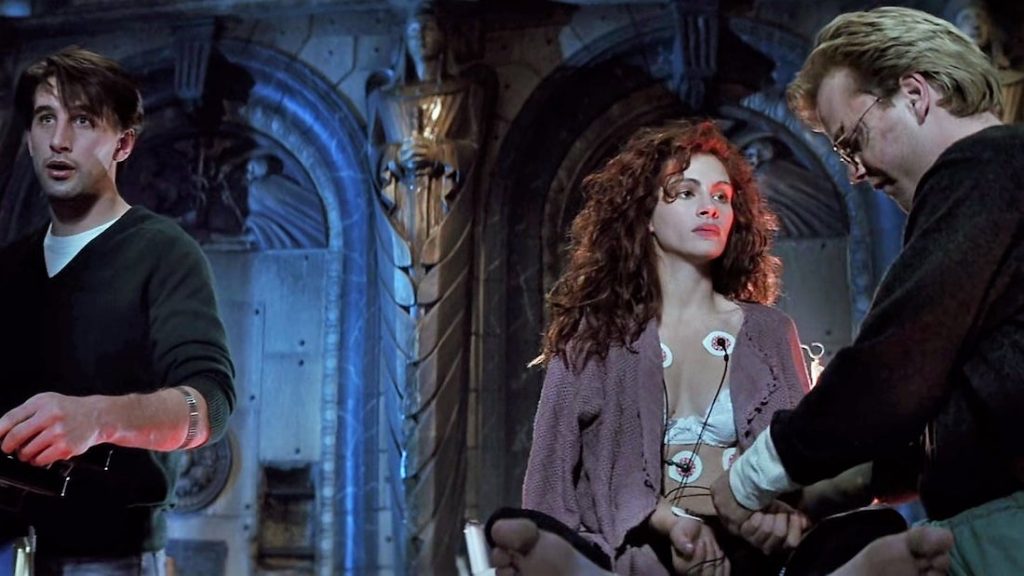
The cast used the Filardi’s research into NDEs and consulted technical medical advisor Ruth K Elkholm on the appropriate medical procedures and use of equipment such as EKG machines, to inform their performances.
I love Flatliners because it is such high art American Gothic. The opening shots of dawn over the lakeside, which zoom in on Nelson announcing to himself “this seems a good day to die”, sets the tone for the whole movie. The beautiful statues and paintings preside over a fairly hellish reality of patient’s suffering and the cadavers to be dissected at breakneck efficient pace by the medical students or they lose grades and status, while the nighttime city shots are beautiful, with rich colours optimising the reflections of rain-washed streets. The colours are in fact coded according to emotion, with ‘blue’ an omen of something bad. It keys into all the Frankenstein-style ‘man shouldn’t play God’ vibes and the dark flashbacks to Nelson’s childhood resonate with the ghost of the child Cathy on the moors in Wuthering Heights.
Flatliners even has Halloween costumes and parties, and a Full Moon to add to the gorgeous Goth atmosphere that inspired many rock videos. The late-night city has an eerie atmosphere; at one point Nelson’s shocked by a posse of cyclists that race by almost colliding with him (reminiscent of the lovely 30 Seconds to Mars video for their track “Kings and Queens”).
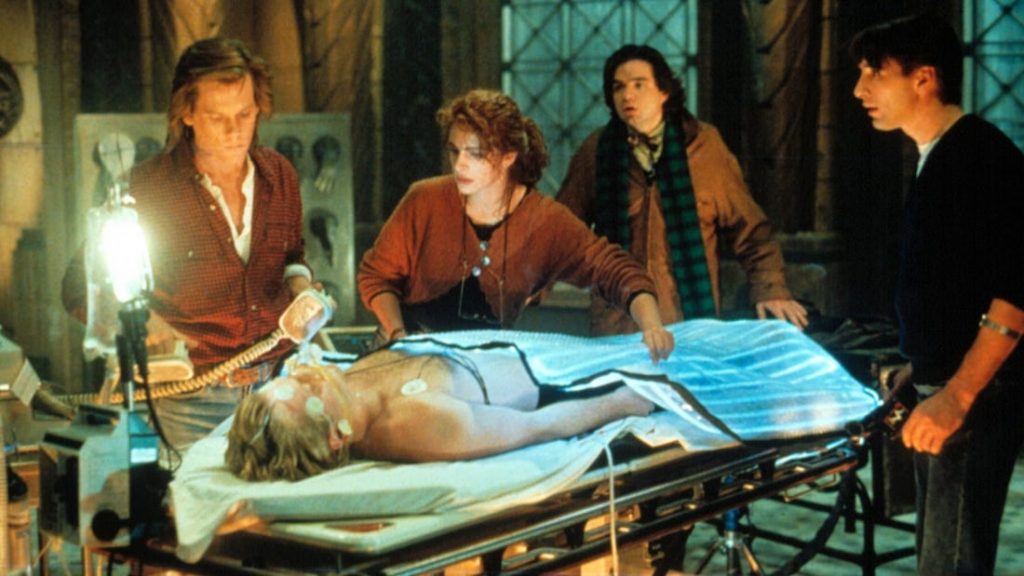
The film’s ultimate topic is accountability. The deep philosophical questions surrounding what really matters in life (how we make a difference while we’re here and how we affect others) are tackled with surprising skill by talented young actors in artistic noir settings. The students are brattish but their human foibles unfold well. Even Oliver Platt, whose character Randy doesn’t flatline, adds annoying humour as a foil. William Baldwin’s playboy purgatory, Kevin Bacon’s pragmatic analyses, Julia Roberts yearning to reach closure… it all feeds into the discussion. They combine to help Nelson during his dark night of the soul, and the abrupt ending is also a satisfying conclusion. It’s worth remembering that Flatliners was made just after Irangate, when ‘accountability’ was a buzz word, and perhaps it’s even more relevant to our lives today.
The movie was a box office success (from a budget of $26M it grossed $61M) which pleased Columbia’s new owners, Sony. The film was also nominated for an Academy Award for ‘Best Sound Editing’ by with supervising sound editor Charles L Campbell (Back to the Future) and Peter C. Franklin sharing the nomination.
Flatliners represented a trend in exploring frontiers between life and death which were prevalent in Hollywood at the time, as Ghost (1990) and Jacob’s Ladder (1990) also came out the same year. Flatliners itself developed into a cult classic on VHS and, of course, a remake eventually happened in 2017 that only proved the magic of the original isn’t easily recreated!
Sadly, director Joel Schumacher died in June 2020, receiving tributes from many Hollywood talents, including one from Kiefer Sutherland who said, “His joy, spirit and talent will live on in my heart and memory for the rest of my life.”
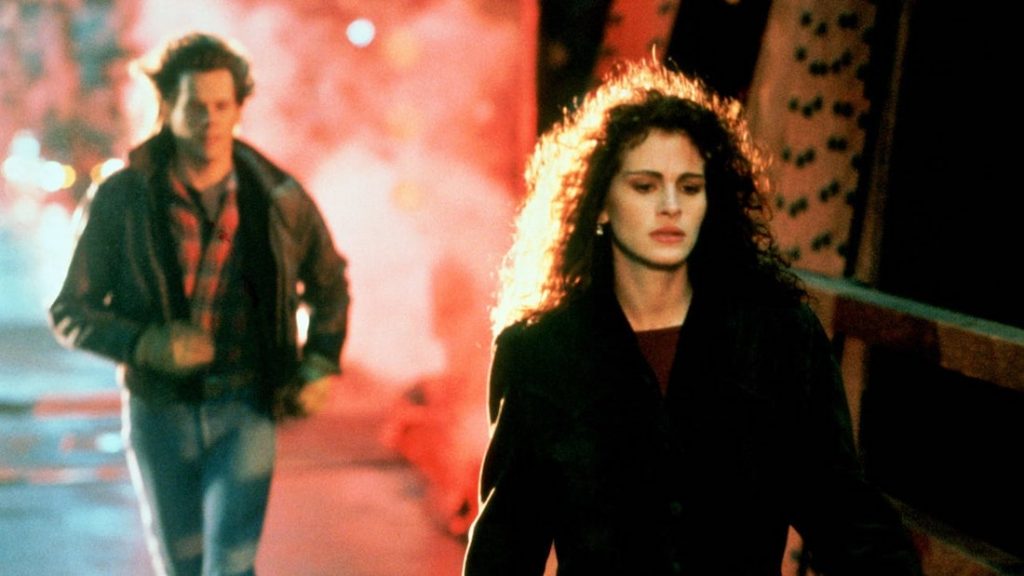
The film’s investigation of NEDs also prefigured other TV series which explored the supernatural such as American Gothic (1995-6), The X-Files (1993-2002), and Medium (2005-2011).
Flatliners is a bit of a love-hate movie, however. You either dismiss it as pretentious twaddle or love it as an artistic, lovingly-crafted Gothic morality tale in the American psychological horror tradition of Edgar Allen Poe, H.P Lovecraft, and Stephen King. I’m a fan, so definitely fall in with the latter category! It tackles the Big Question with style, gusto, a certain level of responsibility, and sensitivity.
It’s also an intriguing insight into ourselves in the very early-1990s. The ambitious Machiavellian Nelson and his competitive fellow students are at times insufferable Yuppies, yet they seem to have an almost innocent charm and heart to us in the 2020s. They tackle their own taste of purgatory with courage and only reluctantly share with each other. They all eventually confess their sins and seek to make amends (even Nelson) whereas current culture suggests that to ‘draw a line under it’ and carry on doing what you are doing, without apology, is acceptable. No doubt this debate will continue, on and offscreen…
USA | 1990 | 115 MINUTES | 2.39:1 | COLOUR | ENGLISH

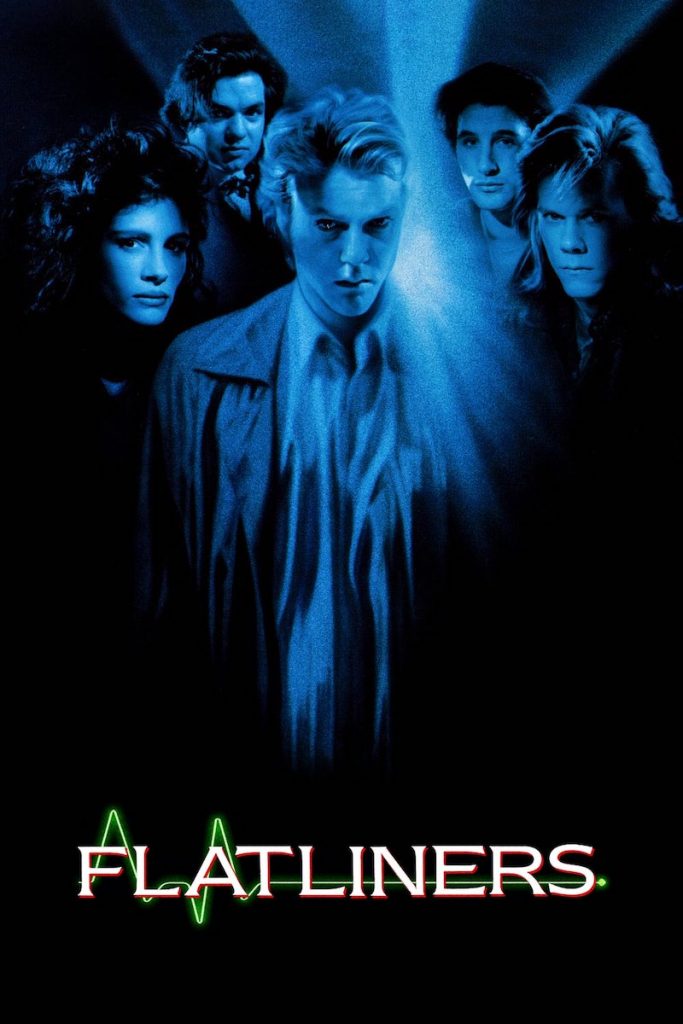
director: Joel Schumacher.
writer: Peter Filardi.
starring: Kiefer Sutherland, Julia Roberts, William Baldwin, Oliver Platt & Kevin Bacon.
